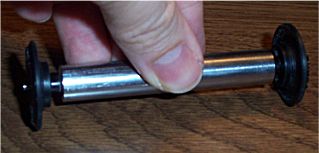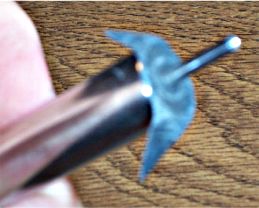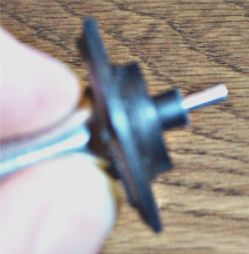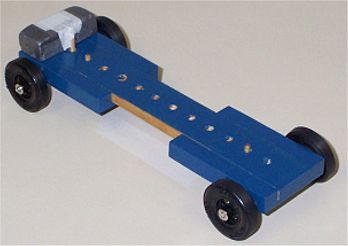
| Pro-Hub Use and Time Trial (Preliminary) | |
|---|---|
| Pinewood Grand Prix | |
| Lastufka Labs | 02 November 2002 |
| Investigators: | Primary: Michael Lastufka
|

Wheels and axles contribute much of the variation in time during a Pinewood Grand Prix. Shaping and polishing the rubbing surfaces is key to reducing friction and excess motion. The hardest challenge is the wheel hub and bore. They are small. The plastic scuffs easily. Typical remedies using the usual home equipment usually make matters worse.
Does the Pro-Hub Tool from www.Maximum-Velocity.com really work? We set out to see for ourselves. Using the two of the lab's adjustable time trial cars, a set of wheels was prepared our "usual" way and the "Pro-Hub" way. Though instructions for the Pro-Hub Tool do not include use on the outer hub end nor the wheel bore, we included those areas in this evaluation.
Installation of the wheel sets were alternated and five runs timed. One car was lubed with silicone spray, the other used graphite with molybdenum. The silicone lubed car benefited from the Pro-Hub Tooled wheel set at a 95% confidence level. The other car showed a higher average time with the Pro-Hub Tooled wheels, but it was not significant for the amount of race-time variation it experienced.
Both the blue and green time trial cars were timed with the Normal and the Pro-Hub treated wheels. Excess plastic was removed and light sanding on a drill with a mandrel rounded up the two sets of wheels before the different treatments. Neither wheel set had cut treads as shown in the pictures.
Normal wheels:
The bores were burnished with an AWANA axle. Both hub ends were burnished with the back end of a hobby knife and the edges rounded slightly by the pressure.
Pro-Hub tooled wheels:
The bores were burnished with the Pro-Hub tool. Both hub ends were sanded with the successively finer sand papers included with the Pro-Hub tool using the coning end.
Burnishing (polishing via pressure to produce heat) is very easy with the Pro-Hub tool. A wheel slips on each end of the rolling pin-shaped tool. Grasping it in the middle, applying downward pressure and rolling vigorously heats the bores to glassing temperature. As pictured below, the wheels tended to wander off the pins, but placing a finger over each end (with a little practice) solves this problem neatly and lets you monitor the heating directly.

Coning the inner hub was very easy and proceeded according to the instructions that came with the tool.
The outer hubs, however, are recessed and the sand paper wanted to crumple between the tool and the face of the hub. There are no instructions covering this situation included with the tool. First, we cut the sandpaper into a small disk to fit inside the recessed area. But it gave us no way to make the sandpaper rub against the hub.

By leaving two tabs that flatten against the middle of the tool, a grip was provided to hold the sandpaper still while rotating a wheel with fingers.

The time trial cars were generally "race" configured with a long wheel base, weight as far to the rear as possible and a front wheel raised. They ran in the same lane each time, the blue car in one lane, the green in another.

| Symbol | Name | Units | Low | High | Method of Change |
|---|---|---|---|---|---|
| P | Pro-Hub Wheels | scalar | Normal -1 |
Pro-Hub 1 |
Clean wheels and axles, mount wheel set, lube. |
| L | Lubricant | scalar | Graphite w/moly -1 |
Silicone 1 |
Race lube - inject in body/bore/axle gaps, spin in. |
Four configurations were timed. The first two involved the green car lubed using graphite with molybdenum, the last two the blue car using silicone spray. The time trial cars are otherwise identical. For each car, the first run used the Normal wheels and the second the Pro-hub treated wheels.
| Number | P | L |
|---|---|---|
| 1 | Normal | Graphite w/moly |
| 2 | Pro-Hub | Graphite w/moly |
| 3 | Normal | Silicone |
| 4 | Pro-Hub | Silicone |
The data below was collected on a "standard" AWANA track by reading the times off the large display of the Microwizard, http://www.microwizard.com/, Fast Track timer[1] and entered into a computer file.
| Configuration | Run 1 | Run 2 | Run 3 | Run 4 | Run 5 | Ave. | St.Dev. |
|---|---|---|---|---|---|---|---|
| 01 | 2.839 | 2.862 | 2.850 | 2.850 | 2.851 | 2.850 | 0.0081 |
| 02 | 2.865 | 2.869 | 2.861 | 2.867 | 2.848 | 2.862 | 0.0084 |
| 03 | 2.863 | 2.861 | 2.855 | 2.851 | 2.857 | 2.857 | 0.0048 |
| 04 | 2.831 | 2.840 | 2.843 | 2.836 | 2.853 | 2.841 | 0.0083 |
A one-tailed "t" test was performed at the 95% confidence level for each pair of Configurations in the table above. A simple 2-level DOE model was derived as well. Both indicated the best advantage was obtained for the combination of Pro-Hub tooled wheels and silicone lubricant. However, the experiment was not properly designed to support this conclusion because neither car was lubed with both lubricants as separate configurations.
Though the silicone lubed car had significantly better performance with the Pro-Hub tooled wheel set, the graphite lubed car did not. Why? The good outcome of the blue car's "t" test was undoubtedly influenced by the lower standard deviation in configuration 3. The standard deviations of the other configurations are almost twice as high. If the Pro-Hub Tool made the contact surfaces smoother, one might expect lower standard deviations in configurations 2 and 4! It appears there are some nuances to be worked out before any general conclusions can be drawn, but there is a glimmer of an advantage.
The next trial should at least include lubing both cars with both lubes. Perhaps using cut wheels would stabilize the standard deviations enough to show whether Pro-Hub Tooled wheels reduce noise and increase speed.
| [1] | The timer was purchased for Lastufka Labs by Dan Kolsar and Jeff Heath at a special price. Thanks Microwizard, it's a great timer! |